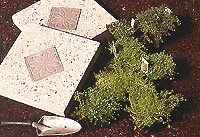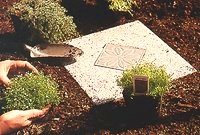





Spring and early autumn -- usually cool and rainy times -- are the best seasons to plant ground covers. But now is a good time to consider where they would work best in your landscape. Use them to soften hard surfaces like walls or paths, to enliven shady spots where grass grows poorly, or to stabilize a steep bank.
Learn even more about growing groundcovers!
continue reading below
Grown along a sunny wall, the trailing lavender flowers of nepeta, or catmint, spill over the edge. After blooms fade, trim plants to encourage a second performance in late summer.

Shade-loving Ajuga reptans shows off spiked blue flowers in spring. The purple-leaf form, shown here, spreads quickly in any well-drained soil.

Woodland gems such as Cornus canadensis, or bunchberry, are equally at home in a moist, humus-rich shade garden. White spring blooms on this low-growing dogwood turn into bright red fruits. Leaves flaunt a burgundy shade in fall.

Red-flowered creeping thyme (Thymus serpyllum) sets sunny sites afire each summer with crimson blooms.

When tread upon, the tiny leaves emit a sweet aroma. Polygonum affine is all foliage until fall, when showy flower spikes give gardens a needed lift.

For dry, sunny spots, try desert plants. Two succulents that survive cold winters are the creeping, yellow-flowered sedum, right, and the mounding sempervivum, also called hen-and-chickens, right.

Chartreuse blooms adorn lady's-mantle (Alchemilla mollis) in early summer, but the 15-inch-tall plants are grown more for their silvery leaves, which pair well with purple-blooming hardy geraniums, right. Lady's-mantle is a perfect edging for a path or a perennial border situated in light shade. In hot climates, locate in a moist, shady site.

Temperate coastal areas offer planting opportunities for tender ground covers. Hebe cupressoides and heather keep company with hardy junipers. A carpet of thyme adds spice at their feet.

Lamium maculatum swiftly fills bare spots in moist, shady areas. The variety White Nancy, left, offers white spring blooms atop green-edged silver foliage. Other forms pair silver leaves with blue or pink flowers.
If you will be buying your ground cover plants by mail, order early for best selection. The number of transplants you'll need depends on the size of theplanting area and how quickly you want it covered. Consider each plant's ultimate spread, too.

Plan pathway materials. Concrete steppers should be spaced at a normal walking stride. A soft sand base underneath the steppers will help you level them.

Good carpetlike ground covers are Scotch moss and thyme--both of which will grow in most climates and in sunny to lightly shaded areas -- To allow forgrowth, space these tiny plants at least 4 inches from steppers.

Figure on spacing a trailing ground cover, such as rubus, 12 inches apart. To block weeds, you'll need to lay landscape fabric, cutting a hole for each plant.

Plant ground covers at the same depth they grew in the pot. A 3- to 4-inch layer of bark mulch around plants will help keep soil moist and cool.
Copyright © www.100flowers.win Botanic Garden All Rights Reserved